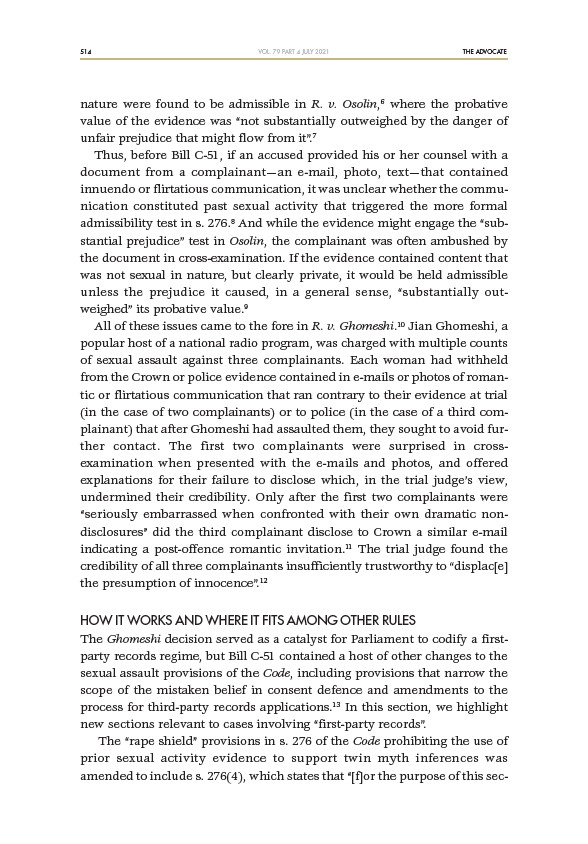
514 THE ADVOCATE
VOL. 79 PART 4 JULY 2021
nature were found to be admissible in R. v. Osolin,6 where the probative
value of the evidence was “not substantially outweighed by the danger of
unfair prejudice that might flow from it”.7
Thus, before Bill C-51, if an accused provided his or her counsel with a
document from a complainant—an e-mail, photo, text—that contained
innuendo or flirtatious communication, it was unclear whether the communication
constituted past sexual activity that triggered the more formal
admissibility test in s. 276.8 And while the evidence might engage the “substantial
prejudice” test in Osolin, the complainant was often ambushed by
the document in cross-examination. If the evidence contained content that
was not sexual in nature, but clearly private, it would be held admissible
unless the prejudice it caused, in a general sense, “substantially outweighed”
its probative value.9
All of these issues came to the fore in R. v. Ghomeshi.10 Jian Ghomeshi, a
popular host of a national radio program, was charged with multiple counts
of sexual assault against three complainants. Each woman had withheld
from the Crown or police evidence contained in e-mails or photos of romantic
or flirtatious communication that ran contrary to their evidence at trial
(in the case of two complainants) or to police (in the case of a third complainant)
that after Ghomeshi had assaulted them, they sought to avoid further
contact. The first two complainants were surprised in cross-
examination when presented with the e-mails and photos, and offered
explanations for their failure to disclose which, in the trial judge’s view,
undermined their credibility. Only after the first two complainants were
“seriously embarrassed when confronted with their own dramatic non-
disclosures” did the third complainant disclose to Crown a similar e-mail
indicating a post-offence romantic invitation.11 The trial judge found the
credibility of all three complainants insufficiently trustworthy to “displace
the presumption of innocence”.12
HOW IT WORKS AND WHERE IT FITS AMONG OTHER RULES
The Ghomeshi decision served as a catalyst for Parliament to codify a firstparty
records regime, but Bill C-51 contained a host of other changes to the
sexual assault provisions of the Code, including provisions that narrow the
scope of the mistaken belief in consent defence and amendments to the
process for third-party records applications.13 In this section, we highlight
new sections relevant to cases involving “first-party records”.
The “rape shield” provisions in s. 276 of the Code prohibiting the use of
prior sexual activity evidence to support twin myth inferences was
amended to include s. 276(4), which states that “for the purpose of this sec-